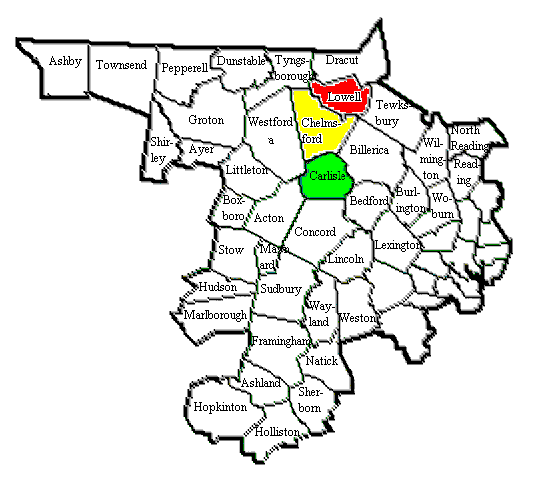
Top Page > Clamps as Products > Makers of Wooden Clamps (WC) > Buttrick
Table of Contents
This page contains a map of "Buttrick Territory", with pictures and descriptions of several types of clamps marked "Buttrick". Most makers made wooden clamps that did not change much over the years, but exhibited great stability of design. Buttrick (along with Bliss, Narragansett, and Grand Rapids) had more than one mark. Buttrick (along with Bliss) had more than one design. These clamps exhibit more variety than most!
Each section has
The organization and presentation is based on the following evidence:

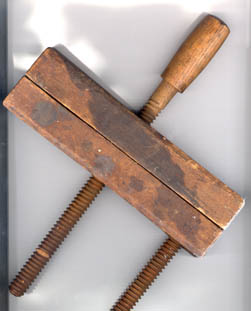 This is in very good condition, except for chipped
thread on the through spindle.
This is in very good condition, except for chipped
thread on the through spindle.
The length of the jaws is 8 1/2 inches, and the spindles are about 3 inches longer. The jaws are very nearly square in cross-section; the slight discrepancy could be due to shrinkage over the years.
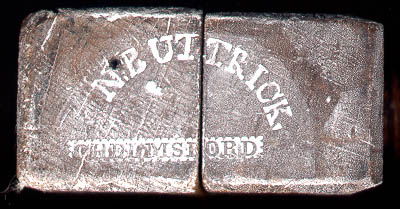 Several things should be noted:
Several things should be noted:
Notice too that (1) the gap between the B and the U, and (2) the
comma after the K, will be found to be present in all these maker
marks. Perhaps there is only only die used all these years!
 I now have (thanks to my son), a clamp marked N.
Buttrick/ Chelmsford (see above) which lacks a slope.
I now have (thanks to my son), a clamp marked N.
Buttrick/ Chelmsford (see above) which lacks a slope.
Other clamps lacking a slope were made by
We may infer that Chelmsford clamps by Buttrick are early, not late. We may also infer that Buttrick was one of the earliest clamp makers, predating Aldrich.
Chamfering is found on several edges. (It is not always apparent, due to wear.) The main chamfer is steeply inclined (some 60 degrees ?) from the outside of the jaw to either the top or bottom side. It can easily be seen in the picture of the maker mark, on the jaw to the right, and in the picture of the through jaw.
In addition, there is minor chamfering on three edges of the back, at some 45 degrees. This chamfering is not even, being deeper on the back/outside edge, and more shallow elsewhere. It can be seen above, on the jaw to the right, and less clearly on the jaw to the left.
There is sufficient wear on the nose that I cannot be sure about the presence of chamfering. The chamfer is on at least 5 edges, and might be on 8 edges in all.
In this only known case, they appear to be original.
 On the early Chelmsford specimen, the spindles are
distinguished. The stopped spindle handle is slightly barrel shaped.
The end is a series of flat faces, with an inclined transition at the
"corner".
On the early Chelmsford specimen, the spindles are
distinguished. The stopped spindle handle is slightly barrel shaped.
The end is a series of flat faces, with an inclined transition at the
"corner".
 The through spindle handle has a slight shoulder, has
a pronounced barrel shape rather than waisted, with an end that is a
series of flats.
The through spindle handle has a slight shoulder, has
a pronounced barrel shape rather than waisted, with an end that is a
series of flats.
In each case, the thread is hand cut, with a double cutter 180
degrees apart. The through spindle shows the farthest cut, while the
stopped spindle shows the end of the other cut.
 The end of the through spindle is a truncated
cone.
The end of the through spindle is a truncated
cone.
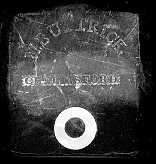 The name is in the same arc that we have seen before.
The "Chelmsford" is in quite a different font and size,
incused with a border. Except that the town is on both jaws, and in
each case, having the same spatial relationship to the name, we might
suspect the town mark was added after the clamp was made. (The
"donut" is the standard hole reinforcer, included for
scale.)
The name is in the same arc that we have seen before.
The "Chelmsford" is in quite a different font and size,
incused with a border. Except that the town is on both jaws, and in
each case, having the same spatial relationship to the name, we might
suspect the town mark was added after the clamp was made. (The
"donut" is the standard hole reinforcer, included for
scale.)
I know that Nathan Buttrick Jr. lived in Chelmsford before 1837. I
have no known links between the other Nathan Buttricks and the
town.
The major chamfer extends down the slope, becoming more narrow as it approaches the nose. The minor chamfer is hard to discern, given the degree of wear on these specimens. I would settle for "major chamfer on four edges" as the key.
We will consider only those that appear to be original.
On the late Chelmsford specimens, the spindles are distinguished. The through spindle handle has a slight shoulder, is robustly barrel shaped, not waisted, with a very rounded end. The stopped spindle handle is slightly barrel shaped. The end is flat, with an inclined transition to the "corner".
The barrel shapes are more prominent on these specimens, compared to the early Chelmsford specimen. This is probably related to their larger sizes. Also, the handle of the through spindle is not symmetric; the swelling is not in the center, but is displaced toward the end.
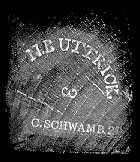
The name Buttrick is in an arc, apparently incised, without border. (This is same arc usually associated with Chelmsford.) The name Schwamb is clearly a separate item, presumably added by the owner after purchase.
The Schwamb Mill did woodworking after 1846 or 1847, and Charles Schwamb 2d ceased working in the Mill in 1902.
We cannot easily associate this to Nathan Buttrick Jr. working in Chelmsford before 1837. It is speculative that, for some while (more than 10 years?) after he moved to Carlisle, Nathan continued to use the arc without a town mark, and he only later began the use of the circular mark.
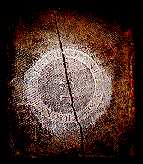 The name Nathan Buttrick and town Carlisle are
integrated into a single circle, bordered inside and out by a narrow
line. A number of uncertain significance is inside the circle. If the
speculation about Schwamb is accepted, then this mark dates from the
1850s and on.
The name Nathan Buttrick and town Carlisle are
integrated into a single circle, bordered inside and out by a narrow
line. A number of uncertain significance is inside the circle. If the
speculation about Schwamb is accepted, then this mark dates from the
1850s and on.
I know Nathan Buttrick Jr. lived in Carlisle from 1837 until his death in 1883. I have no known links between the other Nathans and the town.
There are no significant differences in chamfering.
However, it is clear that Buttrick did not mass produce identical items. There are obvious disparities between specimens, and a lack of uniformity or consistency for each specimen. It is also clear that he did not produce a "line" of proportioned clamps, neatly graded in size. (See the Models, for examples.)
One explanation is that he made clamps intermittently, along with other products in the Mill.
We will consider only those that appear to be original. (For one specimen, the two jaws are married, and the spindles may be also.)
On the late Carlisle specimens, the spindles are so-called "universal". The stopped handle shape is very like the through spindle handle, as described above. It is hard, given the small number of specimens, to determine if the slight differences are intentional, or just manufacturing irregularities.
The threads are hand cut, possibly using different devices.
 The tip is cylindrical, and the diameter is less than
the root diameter of the thread.
The tip is cylindrical, and the diameter is less than
the root diameter of the thread.
 The tip is a truncated cone with fairly shallow angle
to the normal plane of the spindle.
The tip is a truncated cone with fairly shallow angle
to the normal plane of the spindle.
 The handle is slightly barrel shaped. It has a
slight, but distinct shoulder.
The handle is slightly barrel shaped. It has a
slight, but distinct shoulder.
Only one cut is visible. (see above)
 This handle (uniquely) has a distinct waist. The end
is well rounded. I believe that it is married, and not original.
However, from wear marks, it is clear that it was mated to the jaw
for a long while. It may be, on the other hand, that Buttrick made
this variant on a whim.
This handle (uniquely) has a distinct waist. The end
is well rounded. I believe that it is married, and not original.
However, from wear marks, it is clear that it was mated to the jaw
for a long while. It may be, on the other hand, that Buttrick made
this variant on a whim.
Two cuts are visible. However, they are only 60-some degrees apart, not 180 degrees apart. I interpret this to mean that a shallow guide cut was made first, followed by the final cut. This was not made by a box with two cutters that worked simultaneously.
last revised and validated
Copyright © 1996- Wooden Clamp Journal